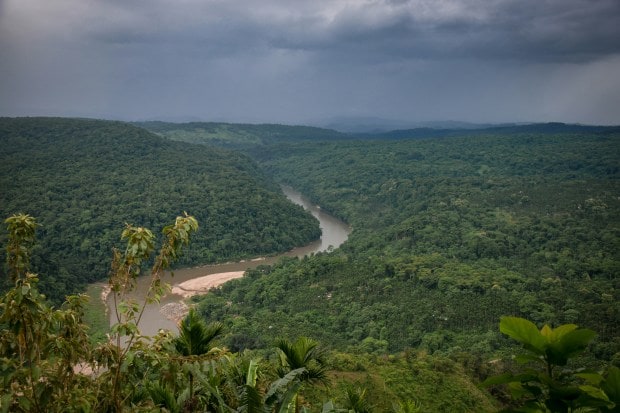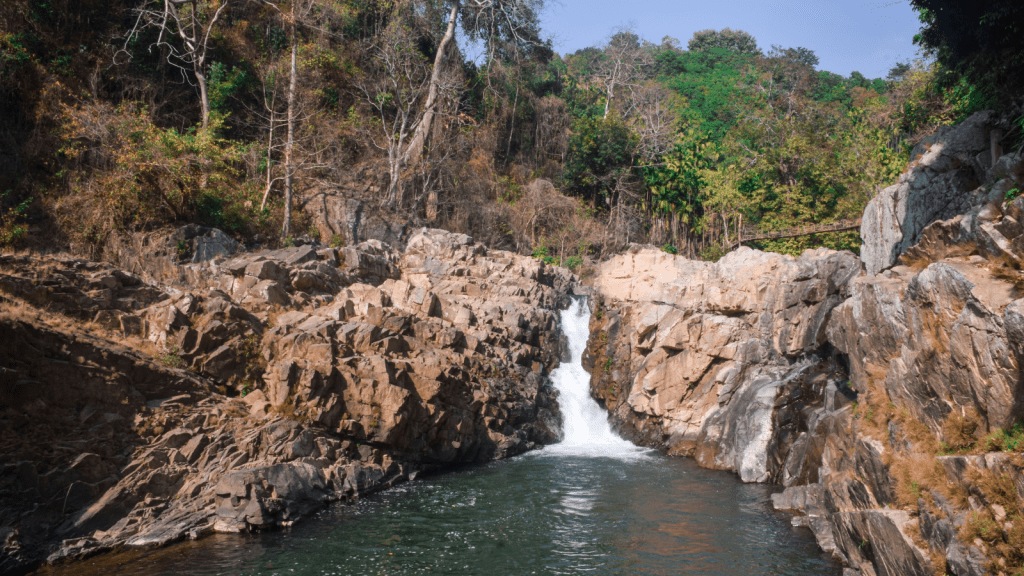Dense forests draped in mist, rivers that vanish into deep gorges, limestone caves echoing with the flutter of bats, and untouched tribal villages make this corner of the Northeast a paradise for explorers who crave wilderness more than comfort. While the Khasi and Jaintia Hills draw most of the attention, it is the Garos’ land that truly tests the adventurous spirit, offering treks through unmarked jungle trails, canyon expeditions, caving adventures, and encounters with some of India’s richest biodiversity.
The gateway to most explorations is Tura, the main town of West Garo Hills. From here, trails wind through the Nokrek Biosphere Reserve, a vast tropical forest teeming with rare flora and fauna. A trek to Nokrek Peak, the highest point in the region, rewards hikers with panoramic views of rolling green hills and distant valleys shrouded in mist. The forests here are home to the elusive red panda, wild elephants, and the citrus Memang Narang, believed to be the genetic ancestor of all oranges. Trekkers spend their days tracing forest paths lined with giant ferns and bamboo groves, their nights in rustic homestays or forest rest houses, lulled to sleep by the hum of cicadas.
From Nokrek, the adventurous trail bends southward to the wilder landscapes of South Garo Hills, where nature puts on a dramatic display. This region is famous for Wari Chora, a spectacular canyon cut through limestone by the roaring Rongdik River. Reaching the gorge is an adventure in itself — a trek through thick rainforest, across suspension bridges and rocky paths that suddenly open to a breathtaking view of turquoise water flowing between towering cliffs. The canyon is best explored through canyoneering, a combination of hiking, wading, swimming, and scrambling over boulders. With the help of local guides, adventurers navigate the narrow water channels, dive into natural pools, and float beneath the shadow of steep stone walls. The experience is raw, elemental, and deeply immersive — an encounter with nature at its most powerful and pristine.
Equally riveting is the exploration of the Siju Caves, located near Baghmara in South Garo Hills. Known locally as Dobakkol, this is one of India’s longest limestone cave systems. Inside, an underground river flows through passages filled with stalactites and stalagmites shaped over millennia. The air is cool and damp, the only sound the drip of water and the flutter of bats overhead. Some parts of the cave are flooded, requiring you to wade through knee-deep water, while others open into vast chambers lit by the narrow beams of headlamps. It’s a surreal journey through geological time, both thrilling and humbling, and one that demands courage and careful guidance from experienced spelunkers.
Beyond caving and canyoning, the Garo Hills invite adventurers to discover its abundant wildlife. The Balpakram National Park, often called the “Land of Perpetual Winds,” is a plateau that local folklore considers sacred — a resting place for spirits. The park is a biodiversity hotspot, home to elephants, bison, leopards, and countless species of birds and butterflies. Treks through Balpakram’s dense sal forests and grassy meadows reveal a landscape of caves, waterfalls, and deep gorges that rival any in the Himalaya. The adjoining Siju Wildlife Sanctuary adds another layer to the adventure, especially for birding enthusiasts, who can spot rare hornbills, kingfishers, and migratory species against a backdrop of forested cliffs.

Closer to Tura, shorter treks and waterfall hikes abound. Tura Peak, a moderate climb from the town, offers sweeping views of the plains of Bangladesh on a clear day. Pelga Falls, a short drive away, provides a softer adventure — a serene setting for picnics, kayaking, and short jungle walks. For those seeking a taste of local culture, village walks through Garo settlements offer insight into a way of life that has remained closely tied to the rhythms of the land. During November, the hills come alive with the Wangala Festival, or the Festival of a Hundred Drums, celebrating the Garo harvest. Adventure here is not only in the terrain, but also in the experience of being part of a living, breathing culture.
What makes the Garo Hills so captivating is their remoteness. Many of the trails are unmarked, and infrastructure remains limited — a challenge that adds to their allure. Reaching Wari Chora or Balpakram requires patience, a sense of curiosity, and a readiness to rough it out. But that’s precisely what makes it rewarding. The people of the region, hospitable and deeply connected to their environment, are now leading efforts to develop sustainable eco-tourism. New glamping sites and community-run lodges are emerging, allowing travelers to experience adventure without compromising the delicate ecological balance.
The best time to visit the Garo Hills is from October to May, when the weather is dry and the rivers are calm. During the monsoon, the same trails turn treacherous — the caves flood, gorges swell, and roads become slippery. But for the rest of the year, this corner of Meghalaya offers unending possibilities for trekking, river adventures, caving, and wildlife encounters. The key is to travel responsibly — with local guides, with respect for the forest, and with an openness to discovery.
In the end, adventure in the Garo Hills isn’t just about physical endurance or adrenaline. It’s about surrendering to the wild — letting the river lead you through its stone corridors, the forest reveal its hidden trails, and the hills tell their stories in whispers of wind and water. It’s about feeling the pulse of a land that still beats to the rhythm of nature, untamed and unspoiled. For those who seek true adventure, the Garo Hills are not a destination — they are an awakening.
